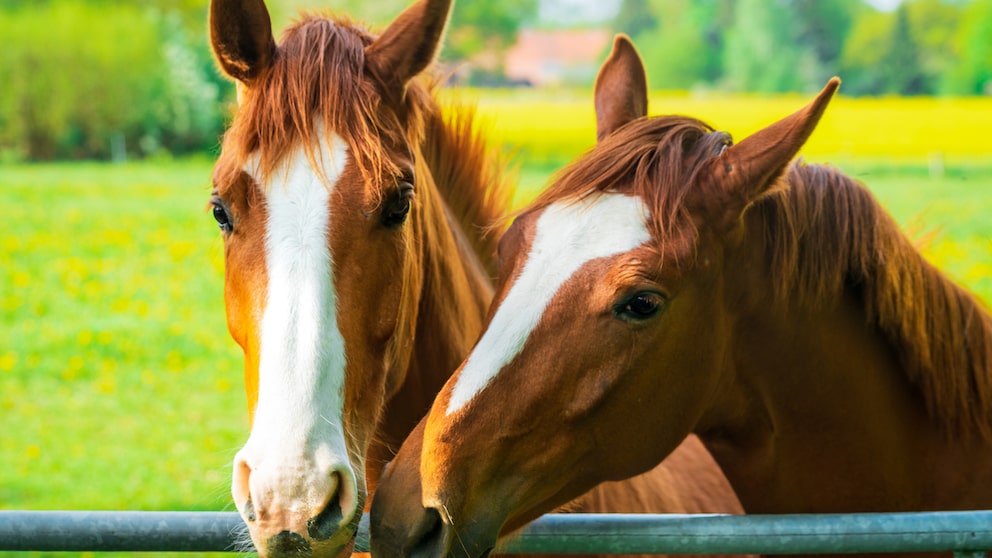June 25, 2024, 9:38 am | Read time: 4 minutes
Many riding enthusiasts and horse owners seem to have an automatic understanding of their animals. The horse shows a certain ear position or tail movement, and the owner knows exactly what it wants. But even laypeople can understand the basics of horse language. PETBOOK shows the most important “expressions”.
A horse turns its hindquarters towards us while pinning back its ears and nervously prancing back and forth. This body language is probably familiar to everyone: the horse is in a fighting mood, something is feeling off for them, so it is about to lash out backwards. But how does a horse behave when it wants to be stroked, when it is hungry, or when it is in pain? Horses use sounds, such as neighing or snorting, to communicate as well, but their most important means of communication with each other and us humans is their body language.
Overview
Horse body language for beginners
Horse keeping beginners, in particular, may be quick to worry. Not only do they sometimes have difficulty interpreting horse body language, but horses are also able to read unsure behavior in humans based on their body posture and movements. Therefore, they usually know exactly who is an experienced horse lover and who is completely haphazard when it comes to riding.
Neighing and growling in all tones
Even though body language is the most important means of communication for a horse, neighing is also characteristic. The natural habitat of horses includes vast steppes and grasslands, and often stretches over many kilometers. Over such distances, other horses cannot be reached through body language. In this case, a kind of shrill neighing helps to say “hello” to other herd members or friendly horses. Mares tend to call their foals with a low growl; familiar people are also greeted in this way.
Posture
Relaxed horses are easy to recognize, even for a layperson. They usually have a relaxed posture; their head is lowered rather than upright, one leg is bent, and their tail can be seen brushing no more than a few flies off their hindquarters. The tail is otherwise completely still. Some horses also like to roll around in the sand or lie down and doze off when they are relaxed. If, on the other hand, the horse is excited, this is reflected in the muscle tone of their entire body. The horse has tension in every fiber; their legs are pushed through, their head is upright, their nostrils are slightly flared, and their ears are upright and alert, pointed in the direction of most interest. The tail also whips back and forth excitedly.
Eyes
The look in the horse’s eyes can paint a picture that is worth a thousand words. A relaxed, clear look from the horse simply means that they are doing well. Wide-open eyes with the white part of the eyeball visible, on the other hand, indicate fear or aggression. In this case, caution is advised.
Horses’ ears
It is often said that horses communicate with their ears. In fact, many of the moods of a horse can be interpreted through the position of its ears, as this is also an expression of horse body language.
- Upright, pointed ears: The horse is alert and focused, or it is showing interest in something.
- Ears tilted slightly back or to the side: dozing, relaxing
- Ears that are set back tightly: Be careful; the horse is not in a good mood, or might even be aggressive! This position of the ears often indicates a threatening gesture towards other horses.
- Ears that are differently aligned: one ear points backwards, the other one forwards, or to the side. In this case, the horse is surrounded by several stimuli and tries to be attentive to all of them.
- Ears laid back while riding: While riding, laid-back ears are usually just a sign that the horse is focusing its attention on the rider.
Horse’s mouth and lips
Although a horse’s mouth is one of the most sensitive parts of its body, it is often ignored by laypeople when it comes to recognizing a horse’s mood. However, horse emotions are shown in this area. A relaxed horse has its lips hanging down in a relaxed manner; sometimes it even opens its mouth and lets its lower lip hang down while dozing. Tense horses tend to press their lips tightly together. Horses that are in pain or sick also show this behavior.
Nostrils
The horse’s nostrils also change when they are frightened or tense. If this happens, the horse inflates them, and its breathing becomes faster. Horses are escape animals, and if they are frightened or worried, this is shown in their nostrils.

On their hind legs, jumping about… How to correctly interpret the body language of rabbits

Tips & Training How to correctly train the rider’s seat and why it is important for the horse


